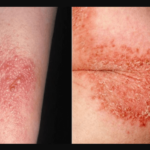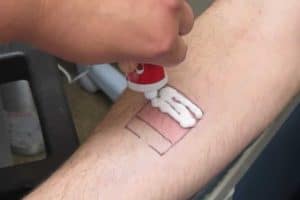It’s frustrating when you get a cut that takes a long time to heal. It helps if you know how long it takes to heal. How long does it take for skin to grow back after a deep cut?
Skin that has been cut takes about 2 to 6 weeks to grow back. The time it takes depends, of course, on the severity of the cut. You can speed up the wound-healing process by keeping the wound clean and keeping it elevated.
In this post, we’ll look at the four stages of the regenerative process:
- Hemostasis
- Inflammation
- Proliferation
- Remodeling
We’ll also look at 5 ways to make the skin heal and grow back faster, including:
- Wash and Cover the Wound (Wounds Heal Faster When Covered)
- Apply Pressure to the Wound
- Keep the Wound Elevated
- Eat Healthy
- Apply a Healing Ointment to the Wound
Read on to learn more about how long it takes for skin to grow back after being cut and how to make it grow back faster.
How Long Does It Take for Skin to Grow Back?
Skin that has been cut generally takes 2-6 weeks to grow back. You can speed up the wound-healing process by keeping the wound elevated and clean.
After a deep cut or wound, the skin that grows back will look different from the surrounding area. The new skin also may not fully regain its abilities for a while or at all.
The top layer of the skin, called the epidermis, consists mostly of hardened cells called keratinocytes and provides protection. Since its outer layer is constantly being shed and renewed, it is pretty easy to repair.
However, a wound sometimes penetrates into the dermis, which contains the blood vessels, various glands, and nerve endings that enable the skin’s many functions. When that happens, it triggers the four overlapping stages of the regenerative, skin-healing process.
Below are the four stages of the wound-healing process of cut skin:
1. The First Stage: Hemostasis
The first stage, hemostasis, is the skin’s response to two immediate threats; the first is that you’re now losing blood and that the physical barrier of the epidermis has been compromised. As the blood vessels tightened to minimize the bleeding in a process known as vasoconstriction, both threats are averted by forming a blood clot.
A special protein, known as fibrin, forms cross-links on top of the skin, preventing blood from flowing out and bacteria or pathogens from getting in. After about three hours of this process, the skin begins to turn red, signaling the next stage – inflammation.
2. The Second Stage: Inflammation
With bleeding under control and the barrier secured, the body sends special cells to fight any pathogens that may have gotten through.
Among the most important of these are the white blood cells known as macrophages, which devour bacteria and damage tissue through a process known as phagocytosis, in addition to producing growth factors to spur healing.
And because these tiny soldiers need to travel through the blood to get to the wound site, the previously constricted blood vessels now expand in a process called vasodilation.
3. The Third Stage: Proliferation
About two to three days after the wound, the proliferative stage occurs when fibroblast cells begin to enter the wound. In the process of collagen deposition, they produce a fibrous protein called collagen in the wound site, forming connective skin tissue to replace the fibrin from before.
As epidermal cells divide to reform the outer layer of skin, the dermis contracts to close the wound.
4. The Fourth and Final stage: Remodeling
Finally, in the fourth stage of remodeling, the wound matures as the newly deposited collagen is rearranged and converted into specific types. Through this process, which can take over a year, the tensile strength of the new skin is improved, and blood vessels and other connections are strengthened.
With time, the new tissue can reach from fifty to eighty percent of some of its original healthy function, depending on the severity of the initial wound and on the function itself.
The full time for the cut or wounded skin to grow back can take anywhere from 2 to 6 weeks, depending on how deep the cut is, how well it is taken care of, and other environmental factors. I’ve had cut skin grow back after surgery take about a month.
When I was younger, I used to have a habit of picking my skin which formed scabs. To get rid of the scabs on your face from picking, it can take weeks, if not months, so please, if you have this habit, please do what you can to stop it.
I also had a cut on my nose when my cat scraped it a few times with her claws. I kept it clean, applied an ointment to it each day, and it healed in only about a week.
However, our skin does not fully recover, and scarring continues to be a major clinical issue for doctors around the world. Even though researchers have made significant strides in understanding the healing process, many fundamental mysteries remain unresolved.
For instance, do fibroblast cells arrive from the blood vessels or from skin tissue adjacent to the wound?
And why do some other mammals, such as deers, heal their wounds much more efficiently and completely than humans? By finding the answers to these questions and others, we may one day be able to heal ourselves so well that scars will be just a memory.
Five Ways to Make the Cut Skin Heal and Grow Back Faster
In order to heal a wound quickly, in addition to being careful with the dressing, it is also important to eat healthily. Eating healthy will help the skin cells repair themselves at a faster rate.
Avoid other harmful lifestyle habits, such as smoking, drinking alcohol, or having a sedentary lifestyle. This is mainly because circulation is impaired, and, therefore, there is not enough blood reaching the wound to allow proper healing, delaying the healing of the wound.
However, it is always important to keep the wound clean to avoid an infection that, in addition to delay healing, can also harm overall health. Thus, listed below are some steps that ensure faster healing and prevent the appearance of ugly scars and other complications.
1. Wash and Cover the Wound (Wounds Heal Faster When Covered)
The first step should be to wash the wound and the skin around it to remove as many bacteria and viruses as possible, preventing the development of an infection.
Washing the wound can be done with a saline solution such as Puracyn Plus Wound and Skin Cleanser, which is non-stinging and ensures the wound heals quickly and safely without risk of infection.
Click here to see it on Amazon.
For surgical wounds or those that are more severe and exposed, although washing is also indicated, it should be done with saline and sterile material, so it is very important to go to the hospital. But if the wound is very dirty, you can apply some serum to remove the dirt before going to the hospital.
Afterward, a dressing should be made at least for the first 24 hours while the crust has not yet formed. Wounds heal faster when they are covered instead of not being covered.
If left uncovered, scab forms and this scab blocks the growth of new skin cells, which slows down or prevents full healing. The faster your skin cells are able to repair, the faster the skin will grow back after the cut.
Use a large waterproof bandage like the Nexcare Waterproof Bandage for knee and elbow, which will withstand showers and baths and keep the wound protected until it heals.
Click here to see it on Amazon.
In order to prevent bacteria from entering the environment into the wound, apply heat to the wound for 15 minutes. This helps increase blood flow to the area by increasing the number of cells in place.
2. Apply Pressure to the Wound
You can accelerate the healing by applying pressure or compression to the wound. This technique can be done two to three times per day but should only be done after the cone has formed.
If the site becomes very swollen or it starts to cause pain, remove the compress and avoid applying heat during the day or apply the compress less than three times.
3. Keep the Wound Elevated
When the wound site becomes swollen for more than 2 days, it is important to try to elevate the wound to reduce fluid accumulation and facilitate blood circulation.
This type of swelling is more common for people who have harder circulation problems and usually arises from leg wounds. Thus, it is important to place the legs about 20 centimeters above the heart level at least 3 times a day or whenever possible.
4. Eat Healthy
Eat omega-3 rich foods, such as salmon, tuna, or chia seeds. You should also eat food that is rich in vitamins A, C, and E, such as orange, mango, tomato, or peanut.
These types of foods are a great way to stimulate the formation of tissue that closes the wounds and helps in the creation of a new layer of skin. Avoid foods that make it difficult to heal, such as sugar, soda, and very fatty foods. The wound will heal faster if you eat healthily and follow the right diet.
5. Apply a Healing Ointment
Healing ointments are also a good option to speed healing because they provide important nutrients for the regeneration of the new layer of skin. In addition, they can also reduce the inflammation that makes healing difficult.
However, they should only be used about 3 to 5 days after the onset of the wound and with the advice of a doctor or nurse, as some ointments may contain antibiotics without being necessary for wound healing treatment.
How long does it take for skin to grow back? Skin that has been cut takes about 2 to 6 weeks to grow back. The time it takes depends on the severity of the cut and how healthy you are. You can speed up the wound-healing process by keeping the wound clean and keeping it elevated.
How to Tell If the Wound Is Infected and Therefore You Should See a Doctor
If one of the healing phases does not occur either due to the lack of blood in the area or an infection, scarring is compromised, and a chronic wound can appear.
Regarding the case of a diabetic foot, for example, in which the wound needs to be treated by a nurse for several months or even years, it would be best to go to the doctor.
Although skin cells and the skin itself grow back and repair themselves, there is always a chance of having an infection on the spot. Thus, it is important to go to the hospital if certain signs develop, such as:
- Intense swelling that does not improve after three days
- Presence of pus in the wound
- Excessive bleeding
- Very intense pain
- Difficulty in moving the affected limb
In addition, other symptoms such as persistent fever or excessive tiredness may also indicate that the wound is infected and, therefore, should also be evaluated.
Conclusion – How Long Does It Take for Skin to Grow Back After a Deep Cut?
By taking the proper care, skin from a deep cut will grow back in about 2 to 6 weeks. The time it takes depends on how deep the cut is.
There are four stages of the wound healing process:
- Hemostasis
- Inflammation
- Proliferation
- Remodeling
To make the wound heal faster, following these tips:
- Wash and Cover the Wound
- Apply Pressure to the Wound
- Keep the Wound Elevated
- Eat Healthy
- Apply a Healing Ointment
I know how frustrating it is to get a deep cut, and watching it heal is like watching paint dry. It will grow back before you know it by following the tips in this guide.
Related reading:
How Long After Quitting Smoking Does Skin Improve?
How Long Does It Take to Shed Your Skin?
How Long Does It Take for Skin to Regenerate?





![Neutral Skin Tone Defined [and Best Colors for Neutral Skin] neutral skin tone](https://skincaregeeks.com/wp-content/uploads/2021/05/neutral-skin-tone-150x150.png)






